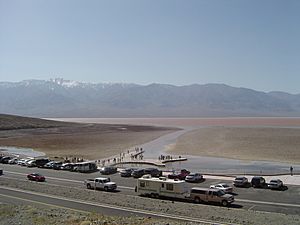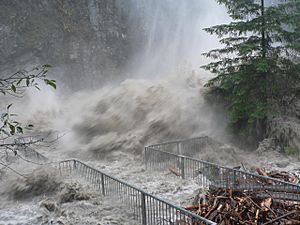Pineapple Express facts for kids
The Pineapple Express is a special weather pattern. It's like a long, narrow river of warm, moist air that stretches across the Pacific Ocean. This "river" usually starts near the Hawaiian Islands and flows all the way to the Pacific coast of North America. It brings a lot of rain and sometimes heavy snow. It's a type of atmospheric river, which is a general term for these narrow paths of water vapor in the air.
Contents
- What Causes a Pineapple Express?
- Big Storms from the Pineapple Express
- West Coast, 1862 Floods
- Northern California, 1952 Storms
- Northern California, 1955 Floods
- Southern California, 2005 Storm
- Alaska, 2006 Rains
- Pacific Northwest, 2006 Floods
- Southern California, December 2010 Storm
- California, December 2014 Storm
- West Coast, 2017 Storms
- California, January 2021 Storm
- Pacific Northwest, 2021 Floods
- California, 2022–2023 Floods
- California, February 2024 Storms
- See also
What Causes a Pineapple Express?
A Pineapple Express happens because of a strong southern branch of the jet stream. The jet stream is like a fast-moving river of air high up in the atmosphere. This weather pattern also involves a slow-moving weather front on the ground. Small low-pressure systems travel along this front, bringing more rain.
Sometimes, a weather pattern called the Madden–Julian oscillation helps create these conditions. This pattern affects rainfall near the equator. Pineapple Express events can also happen during an El Niño episode. El Niño is a climate pattern that changes ocean temperatures.
When this warm, moist air hits the mountains along the western coast of North America, it's forced to rise. As it rises, it cools, and the moisture turns into very heavy rain. This is called "orographic enhancement." These systems often bring a lot of snow to the mountains. This snow can melt quickly because the air is warm. After the air loses its moisture, it can become a warm, dry wind called a Chinook wind in inland areas.
Big Storms from the Pineapple Express
Many Pineapple Express events happen when cold air is already in the northwestern United States. This can cause warm, tropical rain to fall on frozen, snowy ground. This often leads to big floods as the snow melts quickly.
Some famous examples of these events include:
- The Christmas flood of 1964
- The Willamette Valley flood of 1996
- The New Year's Day Flood of 1997
- The January 2006 Flood in Northern California and Nevada
- The Great Coastal Gale of 2007
- The January 2008 Flood in Nevada
- The January 2009 Flood in Washington
- The January 2012 Flood in Oregon
- The 2019 Valentine's Day Flood in Southern California
- The February 2020 floods in Oregon and Washington
West Coast, 1862 Floods
In early 1862, extreme storms from the Pineapple Express hit the West Coast for 45 days. Besides snow melting, some places got about 8.5 feet (2.6 meters) of rain. This caused the worst flooding ever recorded in California, Oregon, and Nevada. It's known as the Great Flood of 1862. Both the Sacramento and San Joaquin valleys were flooded. There were also many mudslides across the region.
Northern California, 1952 Storms
The San Francisco Bay Area also gets hit by the Pineapple Express sometimes. When it does, the heavy rain often causes local streams to flood. City areas can also experience flooding. Before the 1980s, people in the area called these events "Hawaiian Storms." In January 1952, a series of these storms caused widespread flooding around the Bay Area.
These same storms brought a heavy, wet snow blizzard to the Sierra Nevada Mountains. A famous train, the City of San Francisco, got stuck in the snow on January 13.
Northern California, 1955 Floods
The biggest floods in Northern California since the 1800s happened in 1955. This was also due to a series of "Hawaiian storms." The worst damage was in the Sacramento Valley near Yuba City.
Southern California, 2005 Storm

A Pineapple Express storm hit Southern California from January 7 to 11, 2005. This was the biggest storm to hit the area since the 1997–98 El Niño event. It caused mudslides and floods. One desert spot got about 9 inches (229 mm) of rain. Some mountain slopes received huge amounts. For example, San Marcos Pass got 24.57 inches (624 mm). Opids Camp in the San Gabriel Mountains received 31.61 inches (803 mm) of rain in five days. After this, some areas had over a month of almost continuous rain.
Alaska, 2006 Rains
Unusually strong rainstorms hit south-central Alaska in October 2006. Locals called these "Pineapple Express" rains.
Pacific Northwest, 2006 Floods

The Puget Sound region, from Olympia, Washington to Vancouver, British Columbia, received several inches of rain per day in November 2006. This was from a series of Pineapple Express storms. They caused massive flooding in all major rivers and mudslides. These mudslides closed mountain passes. The storms also brought strong winds, which are not always part of this weather pattern. Officials said it was "the worst in a decade." Parts of Oregon were also affected. One spot got over 14 inches (356 mm) in one day. Even the usually dry interior of British Columbia got heavy, coastal-like rains.
Southern California, December 2010 Storm
In December 2010, a Pineapple Express system hit California from December 15 to 22. It brought as much as 2 feet (610 mm) of rain to the San Gabriel Mountains. The Sierra Nevada mountains got over 13 feet (4 meters) of snow. The entire state was affected. However, Southern California counties like San Bernardino, Orange, Riverside, San Diego, and Los Angeles were hit hardest. Coastal and hillside areas had mudslides and major flooding.
California, December 2014 Storm
In December 2014, a powerful winter storm, made stronger by a Pineapple Express, hit California. It brought snow, wind, and flood warnings. A blizzard warning was issued for the Northern Sierra Nevada. This was the first time since October 2009 and January 2008. The storm caused power outages for over 50,000 people. It was thought to be the most powerful storm to hit California since January 2010. A rare tornado even touched down in Los Angeles on December 12.
West Coast, 2017 Storms
Historically strong storms linked to the Pineapple Express caused flooding and mudslides in California in 2017. The San Francisco Bay Area was especially affected. Homes were destroyed, and many roads were closed.
The storm brought a lot of snow to the Sierra Nevada and San Gabriel Mountains. One place in the Sierra recorded up to 800 inches (20 meters) of snow. The storm also caused significant flooding in the Los Angeles area and most of Southern California. About 3 people died. It also brought severe weather to the area.
California, January 2021 Storm
A powerful winter storm brought a Pineapple Express to California from January 26 to 29, 2021. One person was hurt in a mudslide in Northern California. Many buildings were damaged. The storm killed at least two people in California. A large part of California State Route 1 along the Big Sur coast collapsed into the ocean. This happened after huge amounts of rain caused a debris flow onto the highway. In Southern California, the storm caused widespread flooding and debris flows. Thousands of people had to evacuate. It also caused a lot of property damage. Salinas received 4 inches (102 mm) of rain, causing mudflows that forced 7,000 people to evacuate. Across California, the storm knocked out power for about 575,000 people. In the mountains, the storm dropped huge amounts of heavy snow. Mammoth Mountain Ski Area got 94 inches (239 cm) of snow in 72 hours. The total snowfall for the event was 107 inches (272 cm). Blizzard conditions were also recorded in parts of the Sierra Nevada. Very high wind gusts were seen, with gusts over 100 mph (161 km/h) at Alpine Meadows, peaking at 126 mph (203 km/h).
Pacific Northwest, 2021 Floods
Heavy rains from a Pineapple Express event hit the Puget Sound region hard. This was from Bellingham, Washington into the British Columbia Interior and the Lower Mainland from November 14 to 15, 2021. At the peak, Bellingham received 2.78 inches (71 mm) of rain. Hope, B.C., measured 277.5 mm (10.9 inches) of rain. The floods and mudslides that followed closed all major Canadian roads to Vancouver, British Columbia.
California, 2022–2023 Floods
Heavy rains from a Pineapple Express caused widespread flooding in the Bay Area during 2022 and 2023.
California, February 2024 Storms
A Pineapple Express storm hit California from February 1 to 2, 2024. It then moved over the United States, bringing heavy snow to Colorado. Another storm hit from February 3 to 5. The National Weather Service called it "potentially life-threatening." News sources estimated that Los Angeles received six months' worth of rain in 48 hours. The Sierra Nevada mountains got 1 to 3 feet (30 to 91 cm) of snow. Higher elevations, like Mammoth Lakes, expected over 4 feet (122 cm) of snow. Parts of the San Bernardino Mountains' foothills received 10 to 12 inches (254 to 305 mm) of rain.
See also
- ARkStorm
- Pacific Organized Track System
- Siberian Express
- Typhoon Cimaron (2006)




